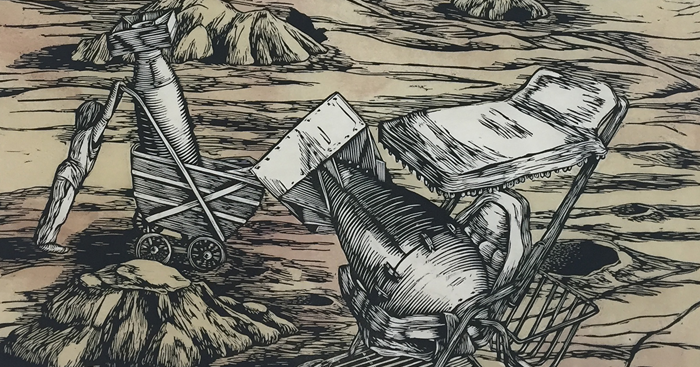
Artist Profile: Edie Overturf
Published January 31st, 2017 by Loren Green
Recently named a Jerome Fellow, printmaker Edie Overturf explains the inspirations and processes behind an ominous new body of work.
Edie Overturf’s work explores themes of history and humanity: mythology, voice, storytelling, and, in an upcoming show at Red Garage Studio, the impending end of it all. In Tales of the Absolute and Preposterous, Overturf puts her printmaking skills on display while exploring where escapism, metaphor, and coping mechanisms intersect.
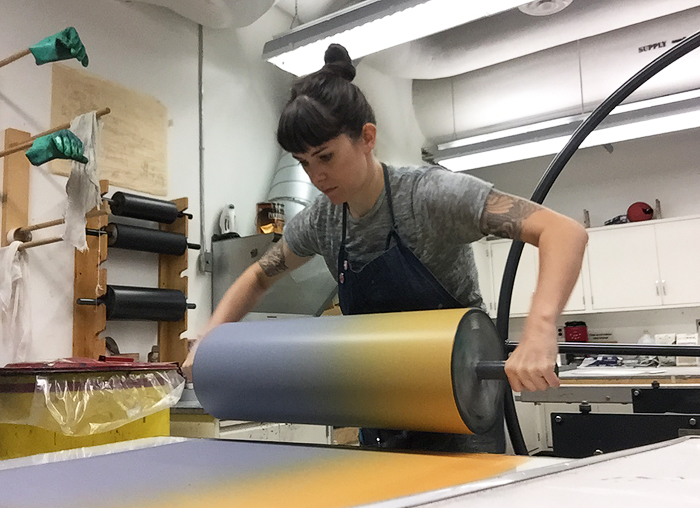 Overturf in her studio
Overturf in her studio
A printmaking professor at the University of Minnesota, Overturf creates most of her work from her studio in the Regis Center for Art on the West Bank but, on occasion, will carve her wood blocks at home with a cat on her lap.
With an MFA in printmaking and sculpture from California State University Chico, Overturf favors woodcuts and etchings in her recent creations. Woodcuts are a traditional medium that predate modern technology, which fits her overlying themes that merge human fantasy with history in the ongoing quest for understanding. She’s particularly interested in how authorship defines those stories, true or otherwise.
In Tales of the Absolute and Preposterous, she embraces religion and pop culture, prophecy and history. Her exhibit will tie in ideas ranging from contemporary zombie folklore to global warming, atomic Armageddon, Y2K, the Mayan calendar, and plagues and floods. It’s not the message of the individual icon that captivates her, but the connective tissue that spans subjects but embraces a theme.
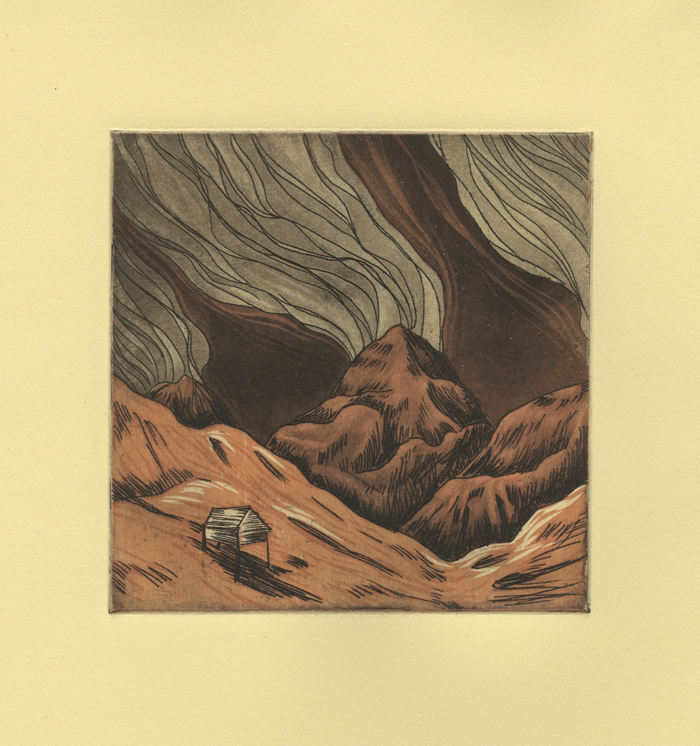 Signals, etching and woodcut, 6"x 6"
Signals, etching and woodcut, 6"x 6"
Whether it’s in escapist literature or an ancient scroll, the certainty of an impending apocalypse is something that humans today embrace and anticipate. “Within escapist art we can move past the horrifying events of WWIII and live in the potentially utopian society after the ‘reset’ button was pushed,” she notes in her artist statement. “I see a parallel between our fascination with ‘resetting’ the world, albeit through horrifying means, and escaping through art and literature.”
As President Trump settles into office, it’s a subject that’s on people’s minds. The exhibit connects woodcuts with monoprint techniques for an added and eerie depth, giving subtle hues to the stark imagery produced by her wood reliefs.
“With these, I didn’t do just woodcut because the line-work didn’t work quite right,” she explains. She wanted something “softer, subtle, kind of spooky.”
To create these monoprints, she creates a Plexiglas image and transfers the ink onto a woodcut by laying the clear surface over her original wood block. It layers a new depth of color in a one-time use. In one of the featured pieces at Tales, the process adds texture to a post-apocalyptic desert scene, in which an atom bomb sits in an otherwise empty stroller. The pink tones give an otherworldly fog amid the clear-as-day iconography: fantasy and desolation.
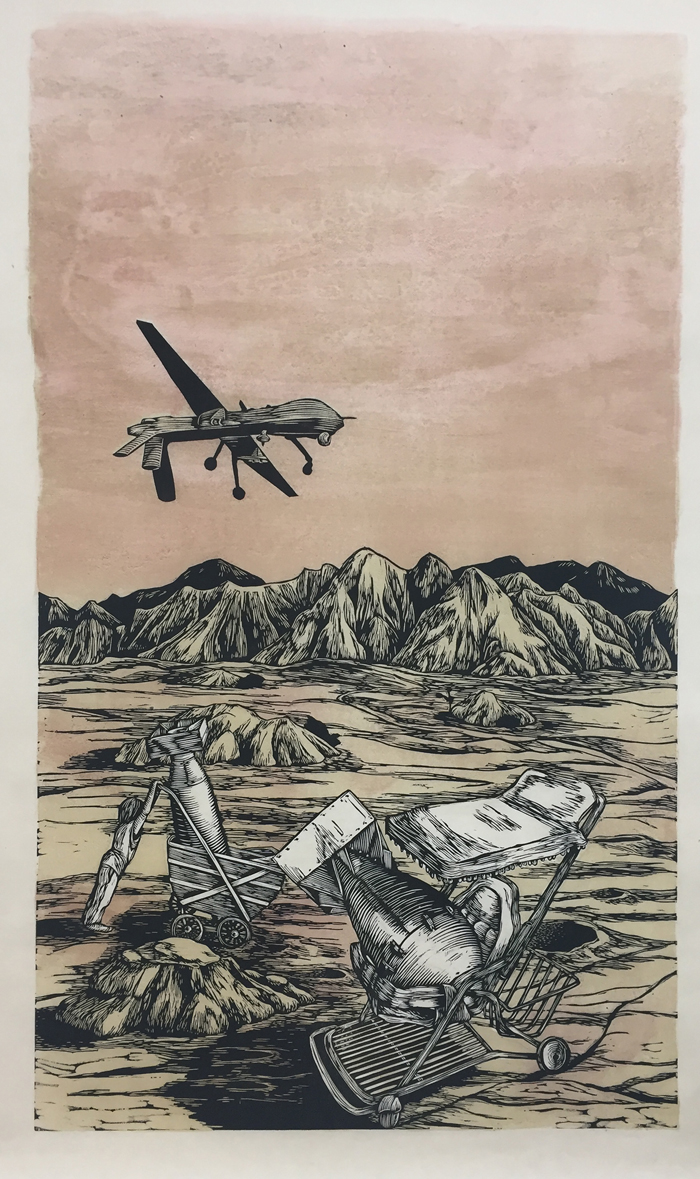 Revisited, woodcut and monotype, 44"X 24"
Revisited, woodcut and monotype, 44"X 24"
Ironically, her precision with woodcuts inspired her to try a new medium for this show. “I wanted to get dirtier and less accurate, which is why I switched to that process,” she explains.
“The process can dictate how it’s going to look,” Overturf says of woodcuts, with each layer of the relief making permanent changes to the work. A pronounced carving error would destroy an image, though she can usually adjust her idea and cover up a minor mistake, she says.
Adding another medium for this body of work made for a challenging system, and the show will feature some of her most time-consuming projects to date. While she has a firm plan going into a piece, she allows room for it to evolve as the prints come alive. Storytelling, after all, is part of her inspiration.
There’s a beginning, middle, and end to all stories, but it’s the narrative voice that truly sets them apart. When to trust that voice is a fundamental (and often overlooked) element that especially appeals to her. With over a dozen pieces set to appear in the show, there is a clear theme between the melting icebergs and the Little Boy bomb, yet no linear tale.
Referencing Margaret Atwood’s writing, Overturf states a desire to share a beginning and end, letting the middle come together by itself. “I’m thinking about those middle moments,” she says referencing a series of smaller works for the show that, displayed near the three large prints, will explore the end-times concept in full. The smaller prints fill those gaps. “It’s right before the pill that kills everybody is made, or right before or after the cataclysmic moment,” she says. The narrative is there but without words, without a storyboard.
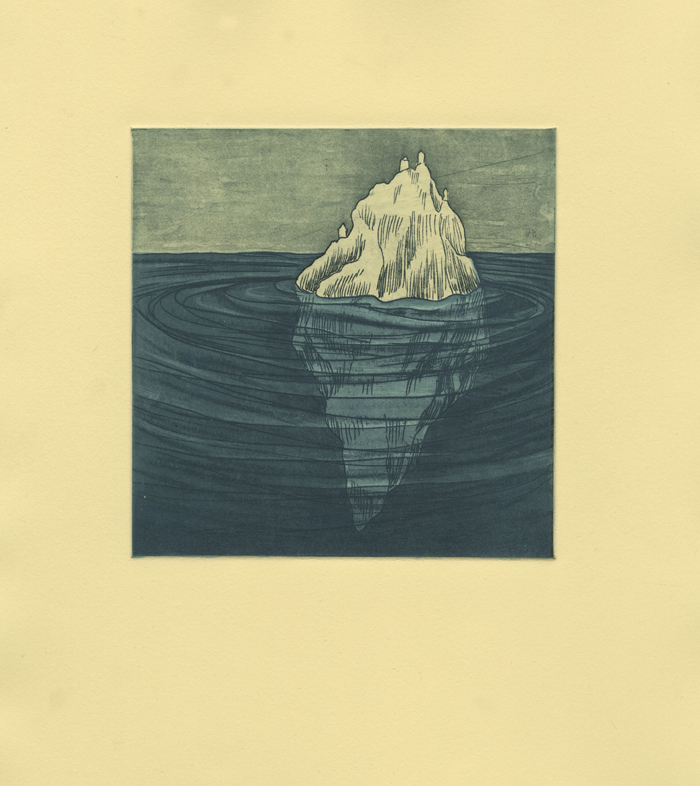 Deserted Island, Etching and woodcut, 6"x 6"
Deserted Island, Etching and woodcut, 6"x 6"
The Art of Woodcuts
“I wasn’t very good at painting when I was an undergrad and I really liked to draw,” Overturf remembers of her first printmaking class. “Carving came natural to me, and the way that you draw, then carve, translated my drawing in a way I couldn’t always predict but I really liked.”
As a teacher, she watches many students learning from the same mistakes she made early on. Yet, everyone has their own vision, their own technique.
“I draw with a really soft pencil, I don’t draw these lines in,” she says, pointing at textural waves surrounding an iceberg. “I draw shading and decide later how the marks will make that radiant…That’s the part I find fun. Some carvers will take their wood and draw with a sharpie marker exactly where the black is going to be. I don’t find as much pleasure doing that.”
Many first-timers will draw an image without varying the size of the marks, creating an image without depth. Another trick learned with time is knowing when to stop, planning out the different prints possible with a single block of wood.
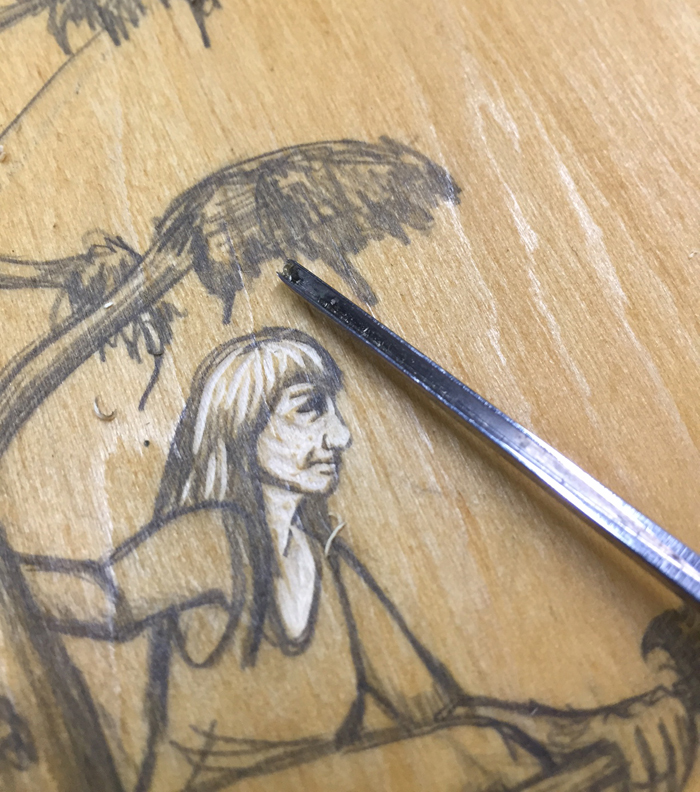
She often uses reductive woodcuts, continually carving at the same block and printing in different colors until the relief is slowly carved away. It requires careful preparation as there is little margin for error. Ultimately, the process comes from the unique character of translating a drawing into a printed image.
“You can change the mood depending on the process,” she explains. The variety can breathe new life into a work, while incorporating another technique such as monoprint adds a new layer altogether.
Jerome Fellowship
After dedicating herself to preparing for Tales of the Absolute and Preposterous for the past few months, she is ready to switch gears. Overturf was named a recipient of the 2016-17 Jerome Foundation Fellowship for Emerging Artists by the Minneapolis College of Art and Design.
Along with four other recipients, she will meet with curators and critics over the coming year, organizing a group exhibition in September 2018. “I can see myself exploring conspiracy and revisiting historical ‘truths,’” she says. “The methods I [will] use for this are yet to be seen, and will be determined by the concepts as they develop.”
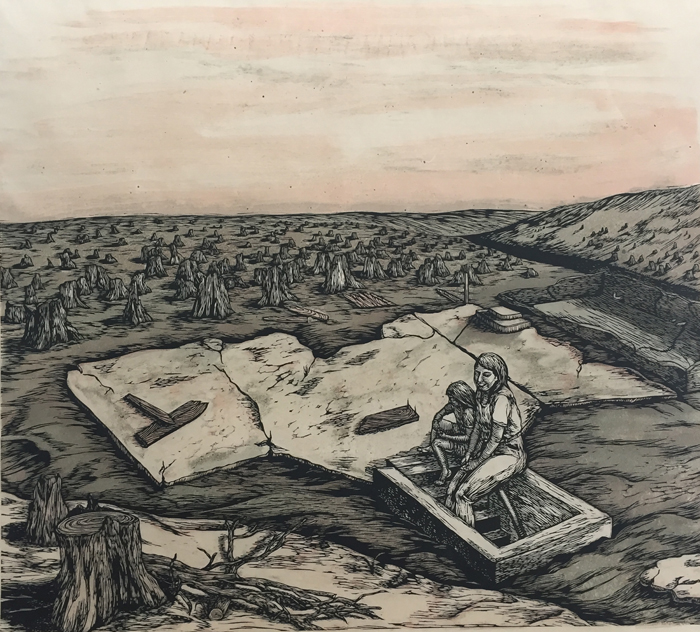 Swept, woodcut and monotype, 30"X 36"
Swept, woodcut and monotype, 30"X 36"
Tales of the Absolute and Preposterous will be on display at Red Garage Studio from April 21 - 30, 2017 with a reception Friday, April 21st 7-10PM. For more information on the artist, visit edieoverturf.com.
We can't do it without you.
Help keep independent arts journalism alive in the Twin Cities.